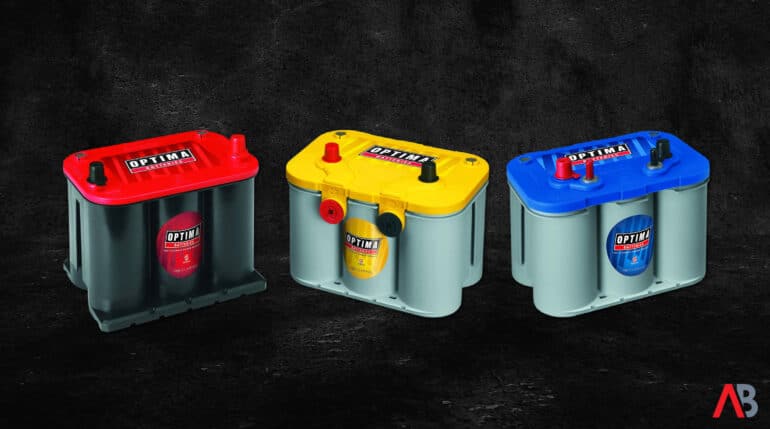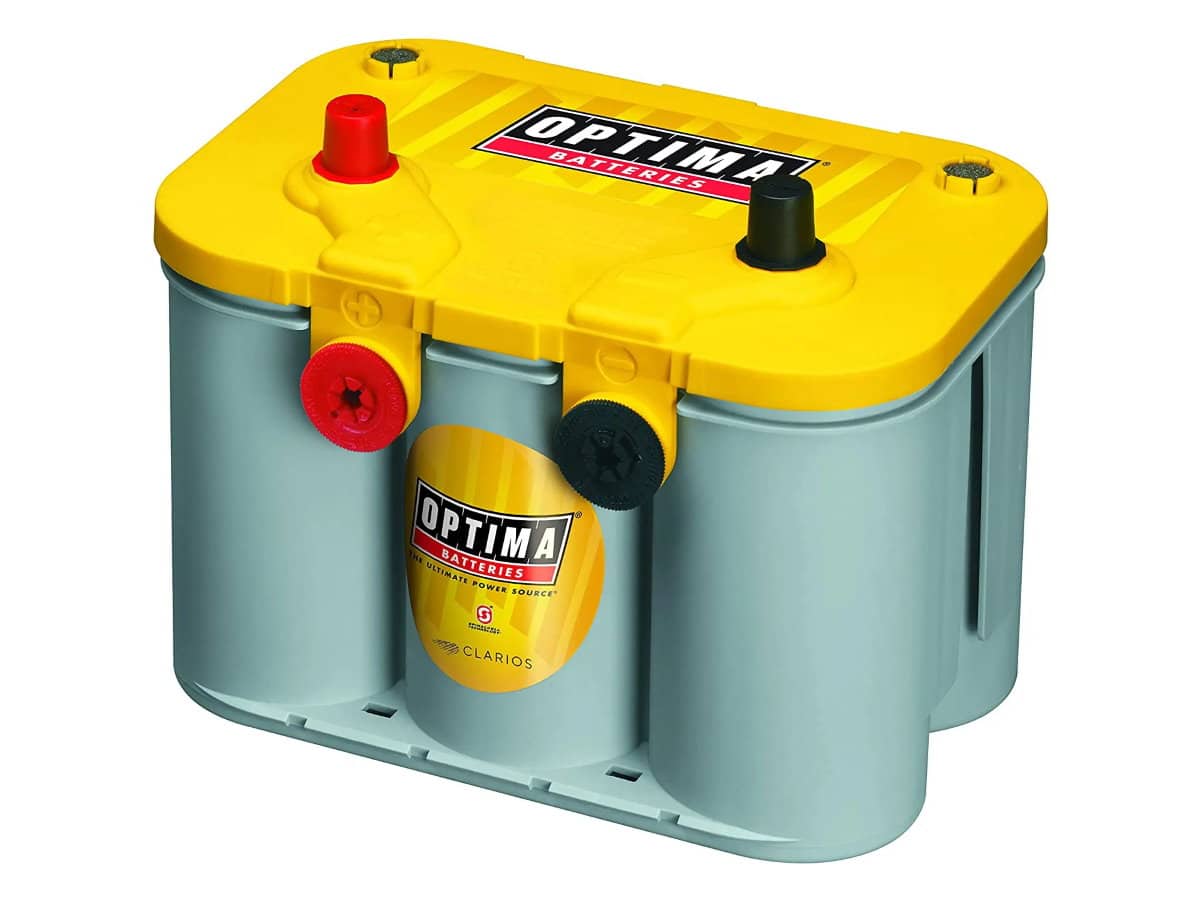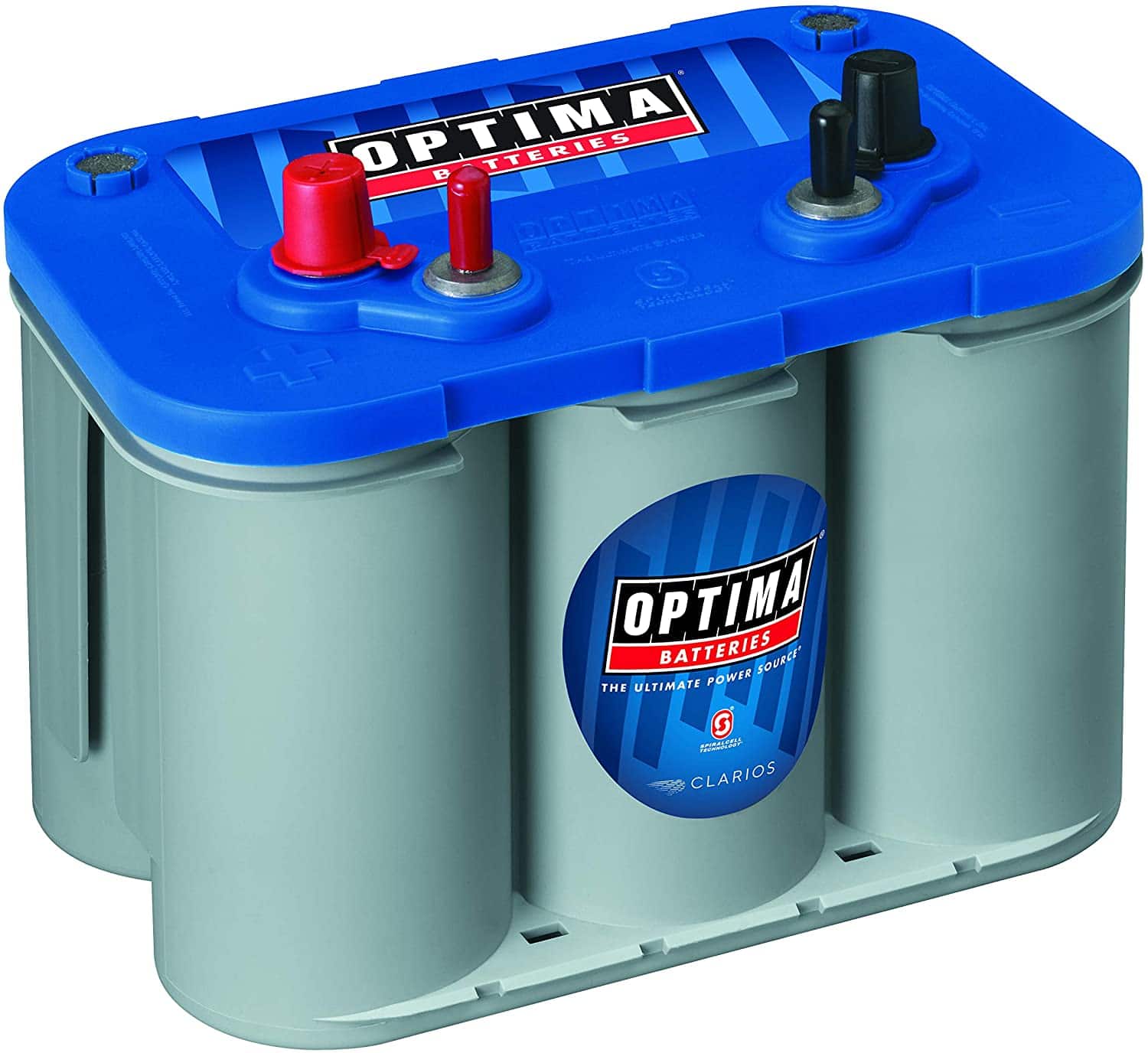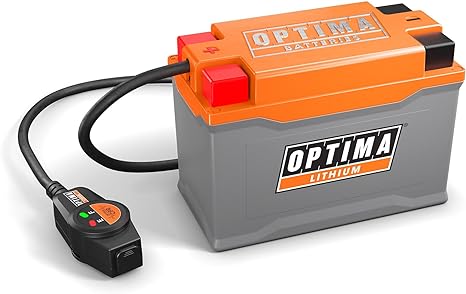Affiliate Disclosure: As an Amazon Associate, Automoblog earns from qualifying purchases. Commissions from Amazon and other affiliate partners come to us at no cost to you when making a purchase via this page. See our Privacy Policy to learn more.
Optima Batteries Summary Points
- With its unique SpiralCell design, Optima manufactures one of the best car batteries on the market.
- This comprehensive guide covers the differences between the RedTop, YellowTop, BlueTop, and Orange Top and sheds light on common car battery terms and technologies.
- Optima battery chargers and maintainers are sold separately via Amazon but are beneficial if you need to bring an exhausted car battery back to life (charger) or are storing your vehicle for an extended period (maintainer).
Optima Batteries Overview
Since the 1970s, Optima batteries have earned a reputation for being a reliable and durable battery for cars, trucks, SUVs, boats, and commercial vehicles.
Optima batteries are available in four variants: RedTop and YellowTop for automotive applications, BlueTop for marine and RV, and the OrangeTop for side-by-sides, motorcycles, and four-wheelers (powersports applications).
Below, we cover the primary features of each and take a closer look at Optima’s technology.
Optima Batteries: Technology & Design
Optima is the only battery manufacturer to feature SpiralCell Technology, giving each a unique shape and form, which the brand calls its “Six-Pack” design.
This design, unique to Optima, results in a less complex and more efficient car battery. The average Optima battery has only about 30 internal components, whereas traditional flat-plate batteries may have well over 100.
Spiral-Wound Design
Optima’s SpiralCell design consists of individual spiral-wound cells composed of two pure lead plates coated in lead oxide. These spiral cells resemble a pastry you might find at the local bakery, hence why Optima batteries are sometimes noted for their “jelly roll” look.
As described by Optima, the pure lead plates are manufactured as a continuous cast strap that maintains key thickness tolerances. The continuous cast strap joins adjacent cells and eliminates welds that would otherwise cause resistance and corrosion points between the cells.
Meanwhile, the two plates have a proprietary separator made of a micro-fiberglass blend that feels like cotton. The separator keeps the two plates from touching while also holding the electrolyte in uniform suspension.
All 12-volt Optima batteries are made of six SpiralCells, each having a fully charged open circuit voltage of 2.2 volts for deep-cycle batteries (YellowTop) and just over 2.1 volts for starting batteries (RedTop).
Manufacturing Process
To maximize the effectiveness of the SpiralCell design, Optima employs a specific manufacturing process that includes custom cell-winding machines.
The SpiralCell (or jelly roll) is inserted into precision-molded cylindrical cases that utilize virgin polypropylene or polypropylene resin that has not been recycled (minimizes contaminants or impurities from pre-used plastic).
SpiralCell Benefits
Optima’s SpiralCell technology offers a few proven benefits.
- Longer lifespan, better recharge capability, and improved deep-cycle capability for vehicles with demanding electrical loads versus traditional automotive batteries.
- More vibration resistance than conventional car batteries as Optima’s design and manufacturing processes lock the plates under the tightest possible compression. This prevents the active paste from coming loose and causing plate-to-plate shortening, which can impact service life and performance.
- Better starting power in harsh weather, be it extreme cold or heat.
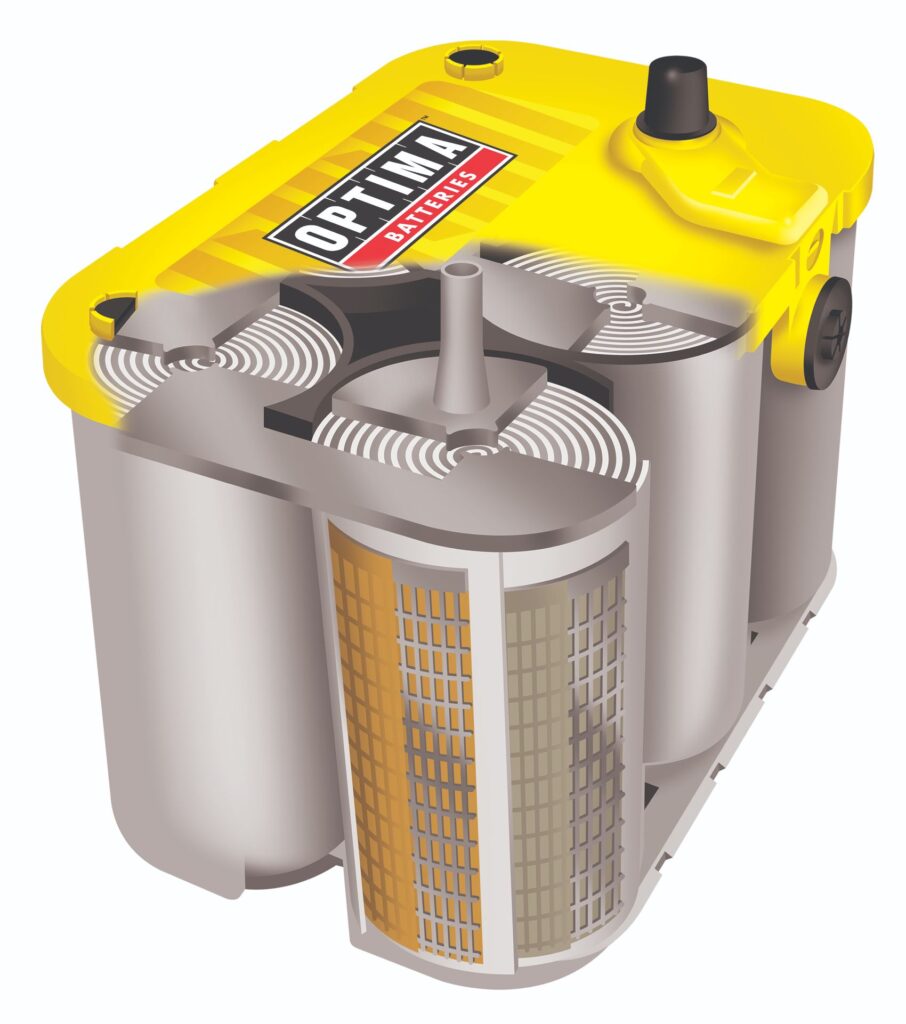
Flooded Lead Acid vs. Valve-Regulated Lead Acid
While there are different types of car batteries for internal combustion engines, two of the most common are flooded lead acid, also known as the wet cell, and valve-regulated lead acid (VRLA).
VRLA batteries differ from conventional wet cell batteries in several key areas:
Maintenance-Free Design
VRLA batteries are fully sealed and often billed as “maintenance-free,” meaning they do not require owners to “service” them with distilled water to maintain the electrolyte levels (although you should do some periodic DIY maintenance, like making sure the battery terminals are clean, for example).
In essence, the sealed design prevents evaporation inside the battery. Optima batteries are classified as maintenance-free because of the SpiralCell configuration.
More Installation Options
Since the sealed design of a VRLA battery prevents spillage and movement of the internal electrolyte solution, these batteries can be installed in more positions than their wet cell counterparts.
As the name suggests, a characteristic of VRLA batteries is a pressure relief valve that activates to vent excess gas under normal operating conditions.
VRLA Benefits
Advantages of a VRLA automotive battery include a longer service life, better vibration resistance, lower discharge rates, and more resistance to extreme temperatures, be it winter or summer.
Sealed Absorbent Glass Mat (AGM) Batteries
The Optima RedTop, YellowTop, and BlueTop are absorbed glass mat batteries, also called AGM batteries for short.
An AGM battery is a style of VRLA battery, meaning it shares the same “maintenance-free” design and can be installed in more positions and places than a conventional wet cell battery.
Construction & Design
AGM batteries harness energy using a mesh of absorbent glass mats (hence the name), sometimes called separators. This differs from a conventional car battery that has hanging positive and negative lead plates that rest in a pool of electrolyte solution.
Unlike traditional flooded or wet cell batteries, AGM batteries use these fiberglass mats, positioned between the positive and negative lead plates, to absorb the electrolyte solution. This allows AGM batteries to store electrolytes in a “dry” or “suspended” state rather than liquid form.
The fiberglass mats, now having absorbed the electrolyte solution, make contact with the lead plates. Optima describes its AGM design as one that holds the electrolyte in suspension, keeping it in constant contact with the active lead material found on the plates.
This results in higher efficiency when recharging and discharging, according to Optima.
Applications & Benefits
As a result of their internal design, AGM batteries are well suited for late-model vehicles with electronic-intensive features, like heated and ventilated seats, navigation, expansive infotainment systems, and start-stop technology.
AGM batteries provide a number of benefits, including more starting power, better vibration resistance, and a longer usable life than traditional flooded lead acid batteries. In some cases, AGM batteries fare better than conventional batteries in areas prone to higher temperatures.
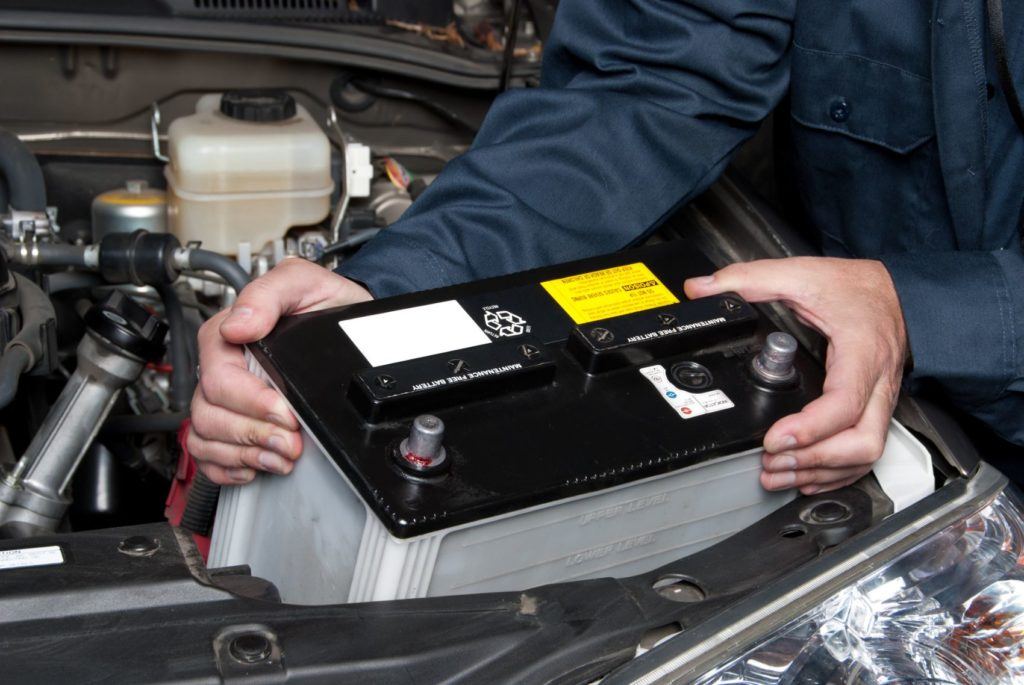
SLI vs. Deep-Cycle
When shopping for a new car battery, you are likely to come across these two terms: SLI and deep-cycle. Here is a summary of each.
SLI Batteries
Starting, Lighting, and Ignition batteries, also called SLI batteries for short, provide quick bursts of power for starting your engine, with enough capacity to support your vehicle’s alternator during normal electrical loads.
SLI batteries have a “shallow” discharge rate, meaning they are best for starting your engine and allowing the alternator to take over. While an SLI battery may be able to handle an occasional deeper rate of discharge and subsequent recharging, it’s not their primary function. Repeated and deeper discharge cycles will shorten their service life.
In Optima’s lineup, the RedTop is an SLI battery that is well-suited for starting your engine. It’s an ideal power source for stock vehicles with a properly working alternator and a reasonable amount of electronic features from the factory.
Deep-Cycle Batteries
Deep-cycle batteries, by contrast, supply the normal starting power to your engine but can also deliver that power over a sustained period, making them better suited for vehicles with greater electrical demands or vehicles without an alternator.
If you drive something with additional accessories and features, either from the factory or installed aftermarket, a deep-cycle battery is a better option. Examples include any vehicle with high-end audio systems, rear-seat entertainment systems or DVD players, winches, off-road lights, and auto start/stop technology.
When vehicles like this are idling, or the engine is off due to an auto start/stop feature, a deep-cycle battery supports the ongoing electrical load. Deep-cycle batteries derive their name from their capacity to handle a deeper rate of discharge in these instances, especially over long periods of time, when compared to their SLI counterparts with shallow discharge cycles.
Conversely, when that vehicle starts moving again, a deep-cycle battery is better equipped to handle the subsequent recharging from that deeper discharge state. In essence, a deep-cycle battery can discharge and recharge repeatedly in a way that SLI batteries are not uniquely suited for.
In Optima’s lineup, the YellowTop is the deep-cycle battery for cars and trucks. Optima BlueTop batteries with a light gray case provide deep-cycling capability for marine and RV applications.
Which Optima Battery Is Right For Me?
The Optima RedTop is a good pick for a daily driver with basic electrical demands. If you have a performance, luxury, or off-road vehicle, the Optima YellowTop is likely the better option because of its deep-cycling capabilities.
The Optima BlueTop is a line of marine batteries, while the OrangeTop is for powersports applications.
Here is a summary of each Optima battery.
RedTop
The RedTop works best as an everyday vehicle battery, providing a quick but robust burst of power for starting your engine. It’s the preferred battery if you have a daily driver with basic electrical demands and a good working alternator.
The RedTop is sometimes listed as the battery for “stock vehicles.” Stock applications outside of everyday vehicles, as defined by Optima for the RedTop, include heavy equipment where starting is the only or primary function and some diesel vehicles without aftermarket accessories or electronics.
Depending on the model, RedTop batteries provide up to 800 cold cranking amps (CCA) and 100 minutes of reserve capacity.
Although a solid all-rounder, Optima RedTop batteries are not designed for deep-cycle use. Putting a RedTop in a constant state of deeper discharge will shorten the battery life. If you need a deep-cycle battery, the YellowTop below is a better option.
Amazon’s AI-generated summary text of customer reviews finds that certain RedTop batteries received high marks for performance and value. However, reactions toward the warranty and overall quality are mixed.
YellowTop
YellowTop batteries are “dual-purpose,” meaning they start your engine and support electrical loads over a longer duration, especially if your engine is idling or off. As an AGM battery with deep-cycling capability, YellowTop batteries are best for vehicles with a high number of factory electronics or aftermarket accessories.
Vehicles that offer a luxurious trim level, such as platinum, premium, or limited, will likely fall into YellowTop territory. This can include, but is not limited to, rear-seat entertainment systems, power running boards or sliding doors, and immersive infotainment or navigation systems.
If said vehicle is equipped with auto start/stop, the YellowTop feeds power to these features while the engine is off.
Likewise, the YellowTop and its deep-cycling attributes are well-suited for anything with aftermarket accessories, including diesel trucks with a power take-off (PTOs), race cars without a charging system (i.e., an alternator or generator), and off-road vehicles with a winch and trail lights.
Amazon’s AI-generated summary text of customer reviews finds that certain YellowTop models received high marks for performance and value. However, reactions toward the fitment appear to be mixed.
BlueTop
This marine and RV battery is available in two versions: starting or dual-purpose. BlueTop batteries with a dark gray case are for starting only, while those with a light gray case will accommodate starting and deep-cycling (i.e., dual-purpose).
As described in Optima’s installation guide, the BlueTop with the light gray case (the dual-purpose one) is best for trolling motors and RVs with a higher number of electronic accessories. By contrast, if the only function for your marine or RV application is starting, you are okay with the BlueTop with the dark gray case.
Also, in its installation guide, Optima clarifies how the BlueTop will have both automotive posts (SAE standard) and threaded studs, while the YellowTop will only have the SAE terminals (the exception being the YellowTop D31T).
Amazon’s AI-generated summary text of customer reviews finds that certain BlueTop models received high marks for starting performance and durability.
OrangeTop
Available in six different sizes, the Optima OrangeTop is a starting battery for powersports enthusiasts. Every OrangeTop has a quad terminal design for a wider range of fitment options. OrangeTop batteries have an IP67 rating to protect against dust and water intrusion.
Key features of the OrangeTop include a built-in system that disconnects it from parasitic loads, an internal battery management system that monitors and protects it, and Optima’s new HyperCore Lithium technology for increased starting performance.
While the OrangeTop is well equipped to handle side-by-sides, motorcycles, four-wheelers, snowmobiles, and personal watercraft, it’s not designed for applications where the battery supplies moving power, like in the case of an e-bike or golf cart.
Similarly, the OrangeTop isn’t designed like an automotive battery, meaning its capacity to handle high accessory loads is limited. However, as a starting battery for your favorite toys, the OrangeTop is a good choice.
Other Helpful Tips
When to buy: If your car is struggling to start, regardless of the weather, or you find that certain things, like your headlights and radio, are not working properly, it’s probably time to get a new battery.
Get the correct group size: Group size requirements will vary by automaker, but the best way to see what your vehicle requires is to consult your owner’s manual.
Remember the warranty: Just as you would do with any other auto part, make sure to read over the warranty when purchasing a new battery.
Ask a trusted mechanic for advice: Qualified automotive technicians have the education, certifications, and experience to help you pick the right battery for your car.
Portable jump starters: If your budget allows, consider a high-quality portable jump starter over a set of jumper cables. Portable units provide the convenience of on-demand power should your battery need a jump in the future.
Optima Batteries Conclusion
Optima combines a unique set of technical innovations with the latest manufacturing processes to produce a battery that suits casual drivers and diehard enthusiasts alike. In addition to automotive, Optima also sells batteries for marine and powersports applications.
If you have a standard (or “stock”) vehicle from the factory, the RedTop is a good pick. However, if you need more muscle for a vehicle with additional accessories, the YellowTop is the way to go. Meanwhile, the OrangeTop will handle ATVs, snowmobiles, personal watercraft, and the like.
The BlueTop is your marine and RV battery with two options. BlueTop batteries with a dark gray case are starting batteries only, while those with a light gray case will accommodate starting and deep-cycling.
Carl Anthony is the Managing Editor of Automoblog and the host of AutoVision News Radio and AutoSens Insights. As a respected automotive industry thought leader, Carl has appeared on numerous podcasts and radio shows, including Wrench Nation, Cars Yeah, The Car Doctor, and Brains Byte Back, in addition to appearing as a regular contributor on MotorMouth Radio on WHPC 90.3 FM. His work can also be seen and heard 24/7 on the Automoblog YouTube channel.
Optima Batteries FAQ
How Cold is Too Cold for a Car Battery?
Your battery won’t freeze in the literal sense unless it’s unbelievably cold. Still, according to AAA, the average car battery can lose up to 60 percent of its available starting power when the temperature hits 0°F or below.
What is Battery Reserve Capacity?
Reserve capacity is the amount of time, measured in minutes, that a completely charged battery will deliver 25 amps of current at 80°F before it’s discharged down to 10.5 volts (for a 12-volt battery).
For example, a battery with a reserve capacity of 120 minutes means it can supply 25 amps for two hours before it dips to 10.5 volts.
In essence, reserve capacity is a representation of how long a battery can deliver power over an extended period of time, whereas cold cranking amps are a measurement of a battery’s capability in quick bursts (like engine starting, for example).
What Are Cold Cranking Amps?
Like reserve capacity, cold cranking amps (CCA) is another important term you will see when shopping for a battery.
In so many words, it’s the number of amps that can be harnessed from a completely charged 12-volt battery at 0°F for 30 seconds while maintaining a voltage of at least 7.2 volts (or 1.2 volts per cell). The higher the number of cold cranking amps, the stronger the “starting power” or “cranking power” of the battery.
For those who live in areas with harsh winters, a battery with a higher CCA rating will have its benefits on cold mornings.
That said, when selecting a car battery, it’s more important to have one that best matches the requirements and specifications of your vehicle instead of one with just a high CCA rating.

